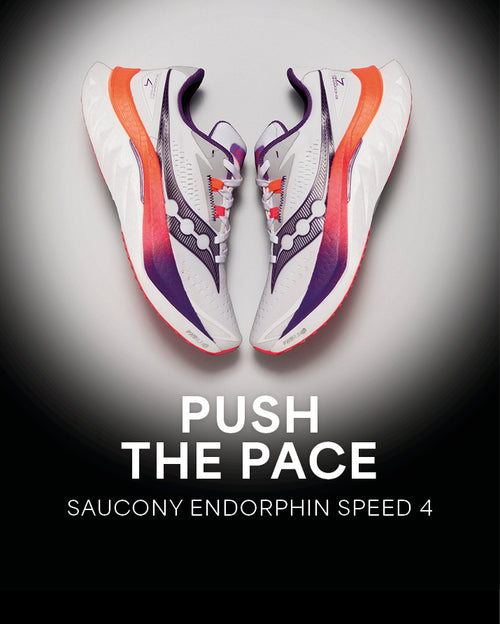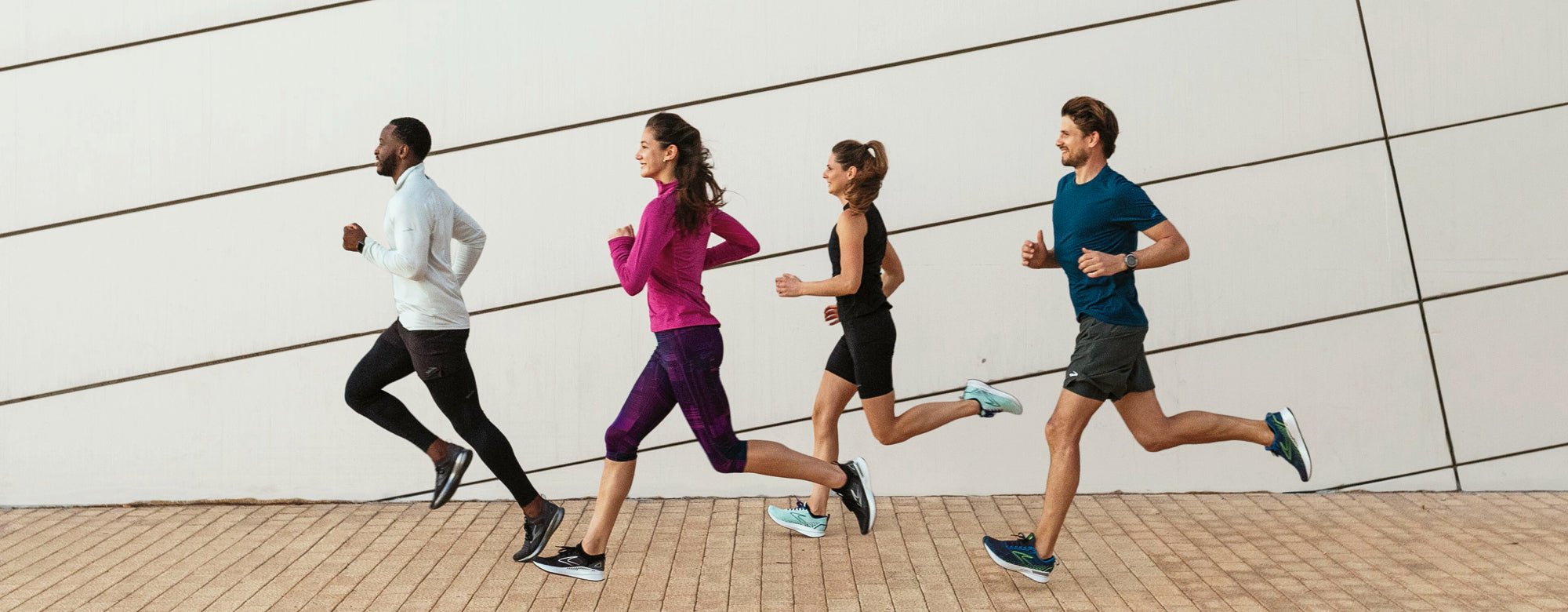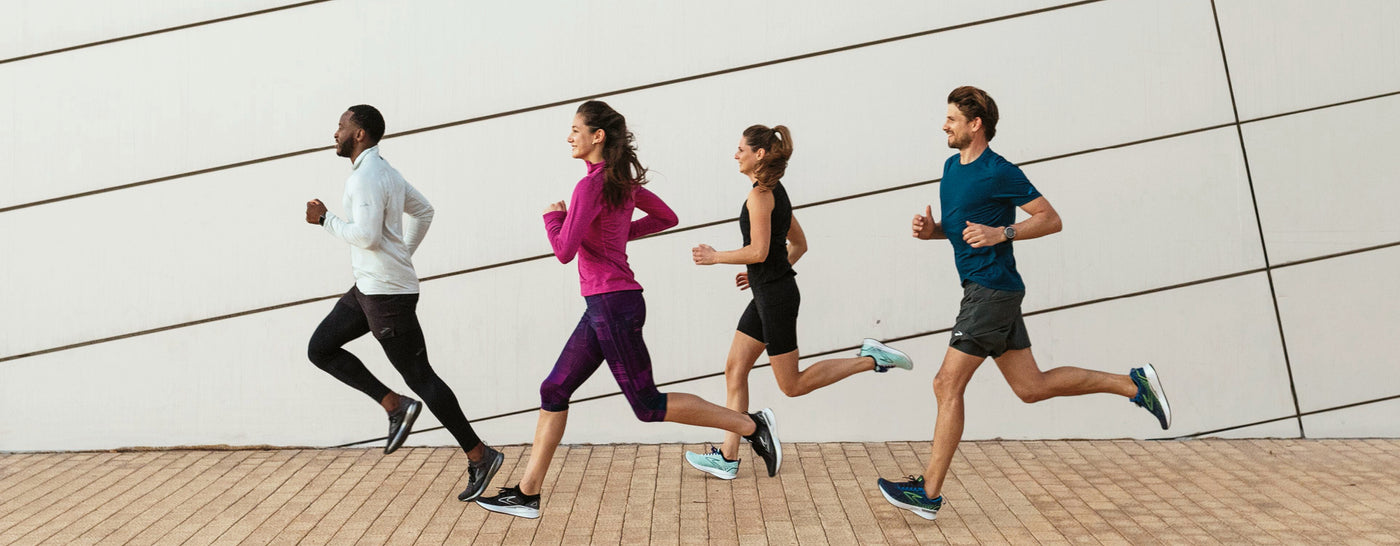Whether you're a beginner embarking on your first ever Couch To 5K or a seasoned runner getting ready for your next marathon, it’s important to pick a pair of running shoes that are suited to you. We understand that it can be overwhelming to choose the right running shoe when faced with thousands of options, however taking the time to pick the right pair can make or break your running experience.
Choosing a running shoe suited to your feet and running style is essential to preventing injury and feeling comfortable as you run. Wearing the wrong style of running shoe or the incorrect size can cause a whole host of problems, from severe pain to muscular imbalances which can impact your performance and your overall health. That’s why we‘ve created this in-depth guide to how to choose the best running shoes for you.
What shoe is best for running?
When deciding what shoe is best for running, the key thing you must consider is the type of surface you will most frequently be running on. This will help you to determine the style of shoe you should be looking for, concerning the type of shape, outsole and level of cushioning needed.
If you’re likely to be running outdoors on pavements, then a neutral and cushioned shoe or a structured, supportive shoe will suit you best as they have more cushioning and shock absorption to help minimise the risk of injury. If you will be running on a treadmill then these shoes will also be the most appropriate choice as the treadmill's surface most similarly resembles road running.
If you run off-road on softer ground and muddy trails then a trail running shoe will suit you better. They offer a deep tread and better ankle support which can help with running on uneven terrain. It’s important to note that trail shoes cannot be worn as running shoes for pavement as they will be unstable and the outsole will wear down very quickly. The studs on the outer sole of trail shoes when worn on pavement can also press into your feet and cause discomfort.
How should running shoes fit?
Getting the perfect fit for your running shoes is essential. The right fit will not only help with your performance but can also help to prevent injury. Therefore, we would always recommend checking the specific measurements of an individual running shoe before buying, as the fit can vary depending on the width of your feet, the height of your arch and also the brand.
A properly fitting running shoe should feel snug around your heel and midfoot, with a little more room around the toes. A great way to check that the fit is correct is to press your thumb down next to the ball of your foot and then around the toes - the correct fit should allow for half to a full thumb’s width of space in these areas. Additionally, we recommend holding down the back of your running shoe and trying to raise your heel, there should be no movement when doing this.
Keep in mind that it’s very common for one foot to be larger than the other, and they may differ by as much as a full size. However, a running shoe that is too small is more likely to cause issues than one that is too big, therefore we would always recommend fitting your running shoe to the size of your larger foot for optimum comfort and support.
To ensure your running shoes are the right fit, we suggest taking the time to accurately measure your foot size and width. Some running shoes naturally have a more narrow fit and therefore may not be suitable for the width of your feet. Having accurate foot measurements to hand can be very useful before you invest in a pair of running shoes, to avoid the disappointment of a bad fit.

Should you size up in running shoes?
The standard running shoe size should typically be half a size larger than your everyday casual shoe. However, each brand of running shoe will vary in its sizing, therefore it is always important to check the specifications for each product to make an educated choice on the right fit for you. It is preferable to wear a running shoe that is slightly too large than one that is too small as this will reduce the chance of potential injury, although we recommend opting for a brand that can provide the right fit.
Which running shoes are best for me?
The right running shoes for you will all depend on what surface you are running on and your gait. As depicted in the graphic below, when running, our feet naturally roll into a motion that helps to reduce the level of shock and impact exerted on them, this is called pronation.


The amount of roll varies for everyone. Those with too much of an inward roll are referred to as having overpronation, typically due to having low arches or flat feet. Overpronation will require a structured and supportive shoe that will help to counteract the excessive rolling and less effective shock absorption.
Opposite to this, those who have excessive outward rolling are referred to as having supination. Supination is usually due to having high arches and should be supported with a neutral and cushioned running shoe to help reduce the impact when running.
Here at Start Fitness, we have separated our running shoes into two main categories, neutral and cushioning and structured and support to make choosing the best running shoe for you simple. Each of these categories offers a wide range of running shoes suited to your pronation to ensure your feet are supported in the correct ways that help to reduce impact and prevent injury.
How often should you change running shoes?
It is recommended that you change your running shoes every 300-500 miles, however, many factors may affect how quickly your running shoes wear out, therefore it is hard to predict exactly when it may be time for a change. If you keep track of your miles using a smartwatch or app, then you will easily be able to work out when you reach the 300-500 mile mark and make an accurate assessment of how your running shoes are holding up at this point.
If you don’t keep track of your runs, you can estimate the approximate mileage based on the average of how far you usually run per week. For example, if you run 15 miles per week then it is likely you will need to replace your running shoes every 5 to 8 months.
However, the wear of your shoes is not just down to how many miles you have run in them, there will be general signs of wear and tear that will indicate when it's time to shop for a new pair. Generally speaking, the outsole of your running shoes will wear down over time from the impact and you will start to feel and notice a difference in the bounce - at this time we would recommend searching for a new pair of running shoes to help prevent injury.
It’s also important to consider how your feet may change as you age. It is suggested that you measure your feet each year and change your running shoes accordingly, as over time your foot arch may start to lower or rise which can impact the size of your foot. Any changes in weight and activity level can also affect a shift in foot size, which in turn may also influence the pronation of your gait and would therefore require a new pair of running shoes.
Find the right fit for you at Start Fitness
Ready to take your next step in the right direction? We've got you covered. Whether you’re buying your first pair of running shoes or you’re a veteran runner, no matter your running style, we've got a wide range of footwear that caters to every kind of runner. Browse through our full range of running shoes from a variety of top sportswear brands to find the perfect pair for you.
If you’re still not confident about how to choose the right fit for you, contact one of our online experts to discuss what running shoe is best for your needs. Alternatively, why not visit us in-store where one of our running experts will be able to assess your gait and assist you?






